In his article on the German cable companies, Bill Glover gives this background to the 1900 German Atlantic cable:
Felten and Guilleaume, a firm of wire rope makers established in Cologne in 1823, set up the German Atlantic Telegraph Company, with the intention of laying a cable on the route Greetsiel - Borkum - Fayal (Azores) - New York.
The Telegraph Construction and Maintenance Company was contracted to manufacture the cable, with Felten and Guilleaume supplying the conductor and armouring wires. CS Anglia and CS Britannia (2) were used to lay the cable with CS Britannia (2) carrying out a survey of the route between Borkum and the Azores prior to the actual laying. The section between Germany and the Azores opened for business on 26 May 1900 and the complete cable on 28 August 1900.
The American terminus was at the Commercial Cable Company’s cable house at Coney Island, and the New York - Horta (Fayal) section of the cable was managed by the CCC for the German company.
The choice of route and the management of the cable involved some politics, as was common in the cable business. In his 1999 book, The Invisible Weapon: Telecommunications and International Politics, 1851-1945, Daniel Headrick gives this analysis:
Felten and Guilleaume made a deal with the Commercial Cable Company: In exchange for landing rights in the United States and access to the Postal Telegraph Company’s American network, the DAT [German Atlantic Telegraph Company] would share the German–American traffic with Commercial Cable, avoiding their mutual enemies, the Anglo-American and the Western Union Telegraph companies. The DAT also obtained landing rights in the Azores from the Europe and Azores Telegraph Company in exchange for a contract to TC&M to lay the DAT’s cable from Borkum to Horta in the Azores, and from there to Coney Island, New York. Thus, the Germans were able to use to their advantage the fierce competition that divided the rival American and British cartels.
The 1900 German cable was very successful and attracted considerable traffic, and a second cable was laid on the same route in 1903-4. This cable was manufactured in Germany by Norddeutsche Seekabelwerke and laid by the company's own cableship, CS Stephan, with CS Von Podbielski assisting. The Emden - Azores section and the New York shore end were laid in the summer and autumn of 1903, and the New York - Azores section in the early part of 1904, with the cable being open for business on 1 June 1904.
The Greetsiel - Fayal and Fayal - New York sections of the cable were made to different specifications; the reason for this is unknown. The details given here are from the Gutta Percha Company’s core manufacturing records, which are held in the Telegraph Construction and Maintenance Company (Telcon) archive at the National Maritime Museum, TCM/21/5, TCM/21/6, and TCM/21/7.
The section from Germany to the Azores (below) was made by Telcon in April 1900, and used four cable types (AA, E, B, and D). The copper conductor was comprised of one wire of 0.114" diameter surrounded by six 0.097" x 0.015" copper ribbon wires, giving a weight for the conductor of 370 pounds per nautical mile. Three coatings of gutta percha were applied, weighing a further 270 pounds per knot, and the overall diameter of the core was 0.379".
1,925.4 knots of this core were made.
Borkum, Germany-Fayal, Azores Sample Case

This display case includes the four samples shown in cross-section below, and layered samples of type AA and type D cables (top).
The case also contains a section of type D deep-sea cable from 1900 (right), picked up by CS Colonia in February 1919; and an unrelated section of four-conductor telephone cable (bottom) laid in 1912 by CS Cambria from Cape Gris Nez - Abbott’s Cliff. |

Type AA
Shore
|

Type E
Intermediate
|
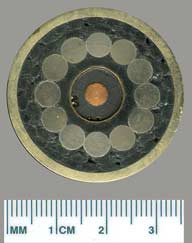
Type B
Intermediate |

Type D
Deep Sea |

Detail of seven-wire core,
showing brass teredo shield |

Detail of conductor, showing six-around-one construction |

Type AA
shore end cable, showing details of construction |
The Azores to New York section (below) was made by Telcon in July 1900 with six cable types (A, A2, E, B, D, and D2), and the specification shows one copper conductor of 0.149" diameter surrounded by four copper ribbons each 0.124" x 0.017", the conductor weighing 600 pounds per nautical mile. Three coatings of gutta percha were applied, weighing a further 340 pounds per knot, and the overall diameter of the core was 0.448".
2,437.85 knots of this core were made.
Telcon’s manufacturing records also show 21.6 knots of core for "German Co 2 core cable", made to this same specification in June 1900; this would have been used to make the type A2 cable shown below, used for the American shore end.
Fayal, Azores-New York Sample Case and Recovered
Cable Specimen
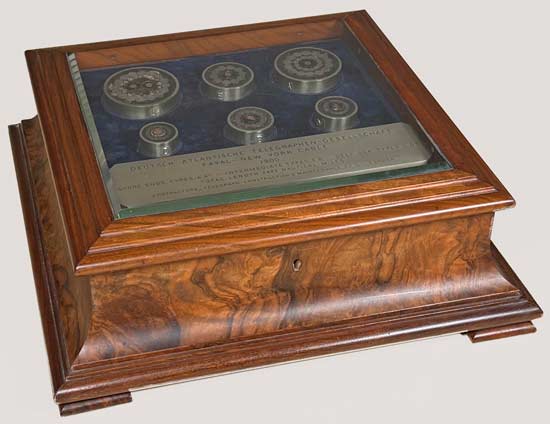
|
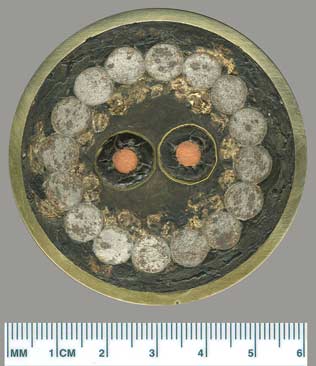
Type A2
Shore with sea earth |
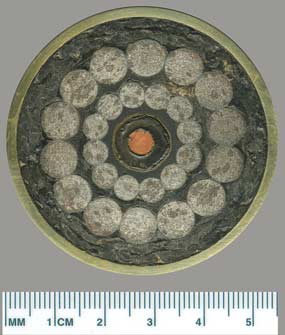
Type A
Shore |

Type E
Intermediate |

Type B
Intermediate |

Type D2
Deep Sea |

Type D
Deep Sea |

Detail of five-wire core,
showing brass teredo shield |

Detail of conductor, showing four-around-one construction |

Above: Section of the type E intermediate cable of the Azores-New York cable,
recovered in the Atlantic about 30 miles off Long Island in early 2009.
Below: Comparison of type E cable from sample case (left) and as recovered (right).
Note that the recovered cable image shows a retaining wire around the sample,
and the outer coverings of tarred hemp visible on the sample case section
have long since disappeared from the recovered piece. |
 |
 |

Sample of core from the recovered cable. The sample shows the conductor formed of
four copper ribbons spiralled around the central copper wire, which is still in
perfect condition after over a hundred years in the ocean.
Cable sample courtesy of Joe Drago, who recovered the cable from the ocean, and his father Bill Drago, who contacted me for information and kindly provided a length of the recovered cable. |
The Brooklyn Eagle reported on the landing of the shore end of the German Atlantic cable at Coney Island in its issue of 12 August 1900:
CABLE END SAFELY LANDED.
Work of Laying to the Azores to Begin
Early in the Week—Testing
Machines Ready.
The preliminary work attending the landing of a new Atlantic cable, which, when completed, will furnish a direct communication between the United States and the Azores, was successfully accomplished yesterday at the cable station at the most easterly end of Coney Island. Chief Electrician Wittrick and several assistants were in charge of the work and they have been preparing the numerous testing machines for the past few days. The first work of the cable was accomplished without a single mishap and those in charge are highly pleased. About ten miles of cable will be laid and it is expected that within the next three or four days the work of laying the entire cable will have been commenced. The cable, when completed, will be the largest that has ever been laid, as well as the first between the United States and Germany. It will furnish a new cable line to Germany from this country, and the cabling between the United States and Germany by way of England will be superseded by a much better system. Between Germany and the Azores there is a cable, and it is said that when the new one is completed much time will be saved and a much better service will result. The total distance which will be traversed in laying the new cable will be about 2,600 miles. This distance will be gone over very rapidly.
Hardly anyone outside of the cable company and its employes knew that a cable was to be landed at Coney Island yesterday, and therefore the work went along very quietly. The cable was arranged in the little cable house and a trench was dug from under the floor of the building to low water mark, in which the cable was laid. The total length of cable laid was about ten knots, and the other end is buoyed at that distance off shore. The steamship Anglia has been selected to lay the cable, and within the next four days that vessel, which is now lying off the Statue of Liberty, will go down to the buoy and attach the cable laid to that already in the vessel and the work of paying out will then be commenced.
During the long voyage of the cable ship the electricians at the cable house at Coney Island will be testing the cable as it is being paid out from the stern of the vessel and in that manner the slightest break can be noticed at once. The machines are nearly all ready and by Friday at the latest the Anglia will commence her trip to the Azores. The new cable is considerably larger in diameter at the shore end than it is in the center, and the electricians said it had been constructed that way because of the fact that at the shore end the anchoring of vessels or the shifting of the tides would tend to wear it out, while in deeper water there is no chance for anything to disturb it. The weight of the cable is about fifteen tons to the mile, and all the rest of the cable not laid is stored in what are known as tanks on the Anglia, ready for the laying. Four other cables are landed at the Coney Island house and the men there are kept rather busy.
The Coney Island landing point of the 1900 cable was at the Commercial Cable Company’s cable house near the east end of Manhattan Beach, a location already used for cables laid in 1884 and 1889 by the CCC. A second cable house adjacent to that of the CCC had been built in 1889 for the extension of the 1881 Western Union Atlantic cable from Nova Scotia to New York.
A second German cable was laid on the same route in 1904.
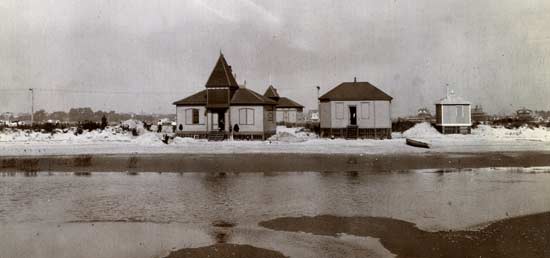
Commercial Cable Company and Western Union
cable houses, Coney Island, 1909
Bill Holly Collection |
According to a report on the Commercial Cable Company published in 1904 by the AIEE (American Institute of Electrical Engineers) the cable houses were situated “one thousand feet east of the Oriental Hotel”, which would place them towards the east end of present-day Manhattan Beach Park. From there the cables ran under Sheepshead Bay then overland (via the Brooklyn Bridge) to the company’s offices at 20 Broad Street in Manhattan. The route of the cable across Brooklyn is described in this 1899 article.
|
The map shows the location of the Oriental Hotel and the Commercial Cable Company and Western Union cable houses (see photograph above). The line beginning at the flag marker at the foot of Ocean Avenue on the north side of Sheepshead Bay shows the approximate route of the landline cable to the CCC offices at Broad Street in Manhattan, which may be followed by dragging or zooming the map.
View a larger map |
In 2007, site visitor Walter Pohl, who at that time worked for Deutsche Telekom in their DTAG International Transmission Center in Frankfurt, Germany, visited Horta on Faial/Fayal Island in the Azores. He took this photograph of one of the surviving cable station buildings at Horta, and has very kindly given permission to reproduce it here.
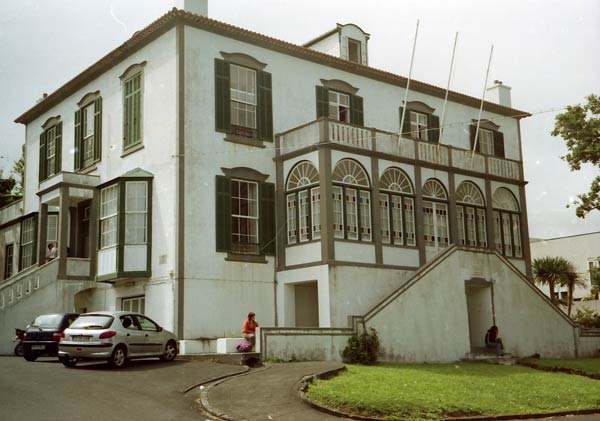
The former building of the Deutsch-Atlantische-Telegrafengesellschaft
(DAT) was being used for offices in 2007. |
|

